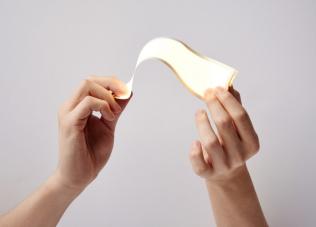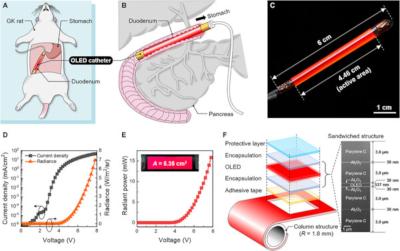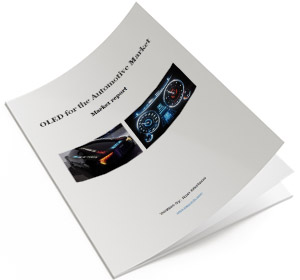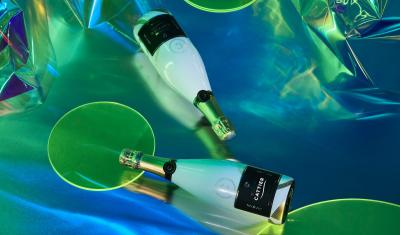OLED (Organic Light Emitting Diodes) are light emitting panels made from organic (carbon based) materials that emit light when electricity is applied. OLED are used today to make beautiful and efficient displays and large, efficient and beautiful lighting panels.

An OLED 'light bulb' is a thin film of material that emits light. OLED is the only technology that can create large "area" lighting panels (as opposed to point or line lighting enabled by LEDs and fluorescent bulbs). OLEDs can be used to make flexible and transparent panels, and can also be color-tunable. OLEDs emit beautiful soft diffused light - in fact OLEDs lighting is the closest light source to natural light (with the exception of the old incandescent lamps).

The OLED lighting market
OLED is an amazing technology for lighting - it creates beautiful, efficient and healthy light sources. OLED lighting has great promise but unfortunately the high price of production is a challenge that no one has managed to overcome and OLED lighting remains a small niche industry as of 2021.
In the early years, several large lighting makers (including GE, Philips, OSRAM, LG, Konica Minolta, Panasonic, NEC and others) had active OLED lighting programs, but slowly almost all of these companies dropped out of the market - for various reasons - but the main one being that the large investments in large scale production are not certified to lead to market adoption and the competition with LED lighting is extremely difficult.
There are several companies that still develop and produce OLED lighting panels, but the production volume is still small and most makers target niche markets such as the automotive, health and premium designer markets. Some makers are also offering OLED lamps - click here for our OLED lamp listings.
Further reading
- An introduction to OLEDs
- OLED Technology explained
- Transparent OLEDs
- Flexible OLEDs
- The OLED Handbook, our very own comprehensive guide to OLEDs
OLED-Info updates its Automotive OLED Market Report
Today we published a new edition of our Automotive OLED Market Report, with all the latest information. The new edition includes new car models with OLED displays and lighting, and updates from several companies, including LG's new automotive OLED strategy. The adoption of OLED technologies by the automotive is accelerating and expected to continue in the future.
Reading this report, you'll learn all about:
- OLED advantages and challenges
- PMOLED and AMOLED displays adopted in cars today
- Why OLED lighting is exciting for car makers
- All about flexible and transparent OLEDs
The report package also provides:
- A directory of all OLED automotive display makers
- OLED lighting roadmaps
- Personal contact details into leading OLED produces
- Car concepts with OLED technologies
- Free updates for a year
This OLED Automotive market report provides a great introduction to OLED display and lighting solutions for the automotive industry. This is a great guide for anyone involved with the automotive market - car makers, suppliers and aftermarket solutions.
Korean researchers developed the first internal-use OLED-based phototherapy platform
Researchers from the Korean Advanced Institute of Science and Technology (KAIST) and the Asan Medical Center (AMC) have developed the world's first OLED-based catheter for phototherapy within internal organs.
OLED-based light therapy has been researched, and even commercialized, before, but only for external use. This is the first time that such a device has been developed for internal use. The device developed by the joint research team is a catheter-shaped OLED platform that can be directly inserted into tubular organs like the duodenum and is water-resistant.
Audi's 2024 Q8 SUV to sport OLED taillights
Audi has unveiled the 2024 Q8 (and SQ8) SUV, which will sport OLED taillights, similar to the ones used in the 2022 Audi A8. These digital taillight OLEDs are supplied by OLEDWorks.
Audi recently announced that the 2024 Audi Q6 e-tron will come with its its second-gen OLED taillight technology, with 360 individual OLED panels built into 6 different lighting panels. The Q8 will likely use Audi's first-gen design, as it is said to be similar the the 2022 A8. The Q6 e-tron will also sport an AMOLED display in the dashboard.
Yeolight starts installing production equipment at its $300 million 4.5-Gen OLED lighting fab
In May 2022 we reported that China-based OLED lighting developer Yeolight Technology is starting to build a 4.5-Gen OLED lighting production line, in Huaibei City, Anhui Province, China. The company is now starting to move in and install the first production equipment. The total equipment cost is estimated at 800 million Yuan (about $111 million USD).

Yeolight says that the new fab, when complete, will have a capacity of around 7 million panels in a year, or 1.2 million automotive lighting modules (probably referring to rear light modules). This will be the world's largest OLED lighting fab, when complete.
Audi unveils its second-gen OLED lighting taillights, to be adopted in the 2024 Q6 e-tron
Audi unveiled the upcoming 2024 Audi Q6 e-tron, with its second-gen OLED taillight technology. The new taillight lighting system use a total of 360 individual OLED panels built into 6 different lighting panels (each made from 60 OLED panels, or segments as Audi calls them), and is able to show warnings and signals to other drivers. The OLEDs are likely produced by OLEDWorks, like all of Audi's recent OLED panels.
Audi will ship the cars with 8 pre-configured digital light signatures, and customers will be able to add their personal light signatures using the myAudi app.
OLED-Info publishes a new edition of its Graphene for Displays and Lighting Market Report
Today we published a new edition of our Graphene for Displays and Lighting Market Report, with all the latest information. Graphene has high potential to improve OLED and MicroLED displays and can be used to enhance displays backplanes, electrodes, emitters and more. In addition graphene can increase efficiency in OLED lighting devices and improve designs.
Reading this report, you'll learn all about:
- Graphene applications in LED and OLED lighting
- Graphene's adoption as a backplane for AMOLEDs
- Transparent graphene electrodes
- Graphene-based encapsulation development
The report package also provides:
- Graphene companies involved with display and lighting
- An introduction to graphene
- An introduction to lighting and displays
- Details about graphene for QDs, lasers and thermal foils
This market report provides a great introduction to graphene solutions for the display and lighting markets, and covers everything you need to know about graphene technologies in these niches. This is a great guide for anyone involved with the displays and lighting.
A new version of OLED-Info's Automotive OLED Market report released
Today we published a new edition of our Automotive OLED Market Report, with all the latest information. The new edition includes three new car models, updates from Samsung, JDI and JOLED, new market forecasts and more. The adoption of OLED technologies by the automotive is accelerating and expected to continue in the future.
Reading this report, you'll learn all about:
- OLED advantages and challenges
- PMOLED and AMOLED displays adopted in cars today
- Why OLED lighting is exciting for car makers
- All about flexible and transparent OLEDs
The report package also provides:
- A directory of all OLED automotive display makers
- OLED lighting roadmaps
- Personal contact details into leading OLED produces
- Car concepts with OLED technologies
- Free updates for a year
This OLED Automotive market report provides a great introduction to OLED display and lighting solutions for the automotive industry. This is a great guide for anyone involved with the automotive market - car makers, suppliers and aftermarket solutions.
Cattier launches OLED-powered interactive Champagne labels
French Champagne maker Cattier launched illuminated and interactive labels, powered by OLED lighting panels produced by Inuru. The project was handled by bespoke packaging platform Packhelp. The Cattier label lights up as the champagne is being poured from the bottle into a glass, and the illumination can be also enabled on demand, by a simple touch.
Inuru says that the first batch of bottles with the new labels will ship soon on select markets. Inuru produces flexible and water-proof OLED lighting panels using a printing process.
OLEDWorks shows new flexible and rigid automotive OLED lighting solutions
Last week at CES, OLEDWorks demonstrated some of its latest automotive OLED Lighting solutions. Developed together with Corning, Valeo and STMicroelectronics, OLEDWorks’ newest demonstrator contained the highest density of individually addressable segments of any flexible OLED panel.
You can see the new flexible OLED demonstrator in the video above on the left (the device on the right uses rigid OLED panels). OLEDWorks says that individually segmented OLED lighting panels increase safety on the road by allowing for improved communication through dynamic animation sequences and symbols. Manufacturing these OLED panels on flexible glass further expands lighting design opportunities with the ability to conform with curved surfaces in the car, integrating lighting directly into the vehicle’s architecture.
Yeolight shows new automotive OLED lighting prototypes
Yeolight showed several new OLED lighting taillights designs at the Automotive Lighting Exhibition in Shanghai. In the video below you can see the various prototypes.
Some of these displays seem very impressive, with a large amount of panels. The full-length taillights have 1,434 OLED panels in different shapes and sizes, and support multiple dynamic effects.
Pagination
- Previous page
- Page 2
- Next page










